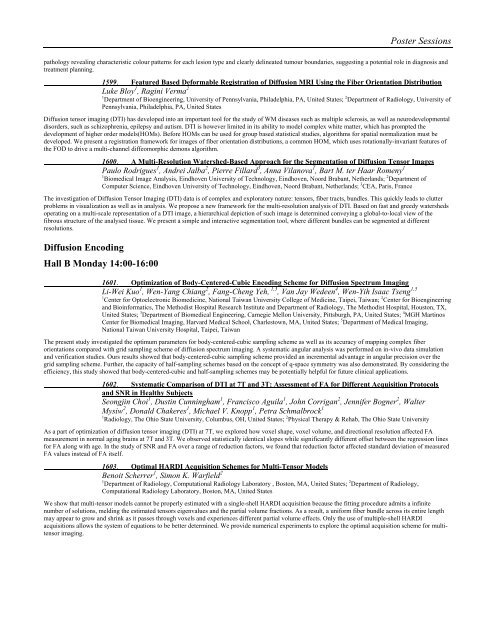TRADITIONAL POSTER - ismrm
TRADITIONAL POSTER - ismrm
TRADITIONAL POSTER - ismrm
Create successful ePaper yourself
Turn your PDF publications into a flip-book with our unique Google optimized e-Paper software.
Poster Sessions<br />
pathology revealing characteristic colour patterns for each lesion type and clearly delineated tumour boundaries, suggesting a potential role in diagnosis and<br />
treatment planning.<br />
1599. Featured Based Deformable Registration of Diffusion MRI Using the Fiber Orientation Distribution<br />
Luke Bloy 1 , Ragini Verma 2<br />
1 Department of Bioengineering, University of Pennsylvania, Philadelphia, PA, United States; 2 Department of Radiology, University of<br />
Pennsylvania, Philadelphia, PA, United States<br />
Diffusion tensor imaging (DTI) has developed into an important tool for the study of WM diseases such as multiple sclerosis, as well as neurodevelopmental<br />
disorders, such as schizophrenia, epilepsy and autism. DTI is however limited in its ability to model complex white matter, which has prompted the<br />
development of higher order models(HOMs). Before HOMs can be used for group based statistical studies, algorithms for spatial normalization must be<br />
developed. We present a registration framework for images of fiber orientation distributions, a common HOM, which uses rotationally-invariant features of<br />
the FOD to drive a multi-channel diffeomorphic demons algorithm.<br />
1600. A Multi-Resolution Watershed-Based Approach for the Segmentation of Diffusion Tensor Images<br />
Paulo Rodrigues 1 , Andrei Jalba 2 , Pierre Fillard 3 , Anna Vilanova 1 , Bart M. ter Haar Romeny 1<br />
1 Biomedical Image Analysis, Eindhoven University of Technology, Eindhoven, Noord Brabant, Netherlands; 2 Department of<br />
Computer Science, Eindhoven University of Technology, Eindhoven, Noord Brabant, Netherlands; 3 CEA, Paris, France<br />
The investigation of Diffusion Tensor Imaging (DTI) data is of complex and exploratory nature: tensors, fiber tracts, bundles. This quickly leads to clutter<br />
problems in visualization as well as in analysis. We propose a new framework for the multi-resolution analysis of DTI. Based on fast and greedy watersheds<br />
operating on a multi-scale representation of a DTI image, a hierarchical depiction of such image is determined conveying a global-to-local view of the<br />
fibrous structure of the analysed tissue. We present a simple and interactive segmentation tool, where different bundles can be segmented at different<br />
resolutions.<br />
Diffusion Encoding<br />
Hall B Monday 14:00-16:00<br />
1601. Optimization of Body-Centered-Cubic Encoding Scheme for Diffusion Spectrum Imaging<br />
Li-Wei Kuo 1 , Wen-Yang Chiang 2 , Fang-Cheng Yeh, 1,3 , Van Jay Wedeen 4 , Wen-Yih Isaac Tseng 1,5<br />
1 Center for Optoelectronic Biomedicine, National Taiwan University College of Medicine, Taipei, Taiwan; 2 Center for Bioengineering<br />
and Bioinformatics, The Methodist Hospital Research Institute and Department of Radiology, The Methodist Hospital, Houston, TX,<br />
United States; 3 Department of Biomedical Engineering, Carnegie Mellon University, Pittsburgh, PA, United States; 4 MGH Martinos<br />
Center for Biomedical Imaging, Harvard Medical School, Charlestown, MA, United States; 5 Department of Medical Imaging,<br />
National Taiwan University Hospital, Taipei, Taiwan<br />
The present study investigated the optimum parameters for body-centered-cubic sampling scheme as well as its accuracy of mapping complex fiber<br />
orientations compared with grid sampling scheme of diffusion spectrum imaging. A systematic angular analysis was performed on in-vivo data simulation<br />
and verification studies. Ours results showed that body-centered-cubic sampling scheme provided an incremental advantage in angular precision over the<br />
grid sampling scheme. Further, the capacity of half-sampling schemes based on the concept of q-space symmetry was also demonstrated. By considering the<br />
efficiency, this study showed that body-centered-cubic and half-sampling schemes may be potentially helpful for future clinical applications.<br />
1602. Systematic Comparison of DTI at 7T and 3T: Assessment of FA for Different Acquisition Protocols<br />
and SNR in Healthy Subjects<br />
Seongjin Choi 1 , Dustin Cunningham 1 , Francisco Aguila 1 , John Corrigan 2 , Jennifer Bogner 2 , Walter<br />
Mysiw 2 , Donald Chakeres 1 , Michael V. Knopp 1 , Petra Schmalbrock 1<br />
1 Radiology, The Ohio State University, Columbus, OH, United States; 2 Physical Therapy & Rehab, The Ohio State University<br />
As a part of optimization of diffusion tensor imaging (DTI) at 7T, we explored how voxel shape, voxel volume, and directional resolution affected FA<br />
measurement in normal aging brains at 7T and 3T. We observed statistically identical slopes while significantly different offset between the regression lines<br />
for FA along with age. In the study of SNR and FA over a range of reduction factors, we found that reduction factor affected standard deviation of measured<br />
FA values instead of FA itself.<br />
1603. Optimal HARDI Acquisition Schemes for Multi-Tensor Models<br />
Benoit Scherrer 1 , Simon K. Warfield 2<br />
1 Department of Radiology, Computational Radiology Laboratory , Boston, MA, United States; 2 Department of Radiology,<br />
Computational Radiology Laboratory, Boston, MA, United States<br />
We show that multi-tensor models cannot be properly estimated with a single-shell HARDI acquisition because the fitting procedure admits a infinite<br />
number of solutions, melding the estimated tensors eigenvalues and the partial volume fractions. As a result, a uniform fiber bundle across its entire length<br />
may appear to grow and shrink as it passes through voxels and experiences different partial volume effects. Only the use of multiple-shell HARDI<br />
acquisitions allows the system of equations to be better determined. We provide numerical experiments to explore the optimal acquisition scheme for multitensor<br />
imaging.















